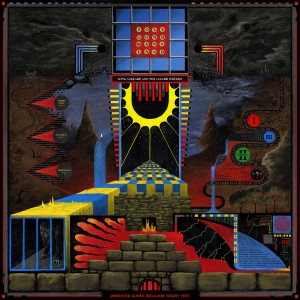 King Gizzard & the Lizard Wizard is a large Australian ensemble that is wildly prolific and insanely creative. In something like 13 albums since the band got together in 2010, they’ve plowed through styles that range from jazz fusion and acid jazz to folk-rock to psychedelic to prog-rock.
King Gizzard & the Lizard Wizard is a large Australian ensemble that is wildly prolific and insanely creative. In something like 13 albums since the band got together in 2010, they’ve plowed through styles that range from jazz fusion and acid jazz to folk-rock to psychedelic to prog-rock.
Polygondwanaland was their 12th overall release, and the fourth of five full-length recordings in 2017. That’s right, five. And it’s available free. From their website.
Let me just say here that if you ever liked anything by Jethro Tull or Pink Floyd or Deep Purple or ELO or King Crimson, you really should go to their website and download the files. (Not to mention Moody Blues and, well, The Doors. Really.) This is a seriously fun record. Also loud. Polygondwanaland is the psych-folk-prog side of King Gizzard’s multi-sided approach to music, which is apparent from the opening track “Crumbling Castle.”
OK, are you back? At 10 minutes, that’s the longest of the 10 tracks on this album, so don’t let it scare you off. But it perhaps sets the album’s themes and definitely includes many of the elements that characterize Polygondwanaland: The mythopoeic lyrics, multiple guitar lines, odd and shifting time signatures, liberal use of polyrhythms and layers of droning analog synthesizers and Mellotron. Not to mention cryptic song titles, including the album title, a portmanteau of polygon and Gondwanaland, the name given by geologists to what they think was once a huge continent in the southern hemisphere some 600 million years ago.
I have no idea what the lyrics say or mean on most of these songs, but that doesn’t trouble me. In many cases, as I mentioned, they’re mythopoeic in nature, so even if you can make them out it’s mostly up to you to decide what they mean. “Crumbling Castle,” “The Castle In The Air,” “Deserted Dunes Welcome Weary Feet” … chapters in a swords-and-sorcery novel, perhaps. Like songs on The Beatles (“The White Album”), several of these songs refer to others on the record. And several seem to identify with themes of sight and color: “Tetrachromacy” is a reference to a perhaps fake condition in which a person sees colors differently. “I heard a story, could it be true / about a color under blue / you couldn’t see it with your eyes, only men with intellect …” or something like that, goes the first verse; likewise “The Fourth Colour,” and perhaps “Inner Cell.” And “Horology” is the study and craft of clock- and watchmaking and repair, as well as this song with its insistent clock-like rhythm.
The real fun for me is teasing apart the rhythmic constructions and reveling in the soundscapes. I’m not a fan of modern electronic dance music and other uses of synthesizers, but I’m enough a relic of the ’60s and ’70s to love the use of them as part of a song’s structure, particularly old Moogs, Arps and Mellotrons. Those animals seem to take over “Deserted Dunes,” but then that’s juxtaposed by guitars, bass and drums in the intro to the next track, “Inner Cell.” The moody and mysterious “Searching…” has lots of actual percussion, including what sounds like a marimba, in addition to droning synths. And the final track, “The Fourth Colour,” sounds like an homage to Mirage-era Meat Puppets with its punk-inspired drum riffs and a rippling Kirkwood-esque electric guitar line.
Several songs feature a particular off-kilter rhythm, the time signature being in three but the emphasis on the third beat rather than the usual first. And in many instances a melody in four beats will be laid over a rhythmic track in three. Time signatures of five or seven beats are common, sometimes in the same song. And amid all of the prog-rock trappings, suddenly a blues harmonica will wail out for a measure or four.
Seven manic musicians all playing multiple instruments, from clarinet to theramin … Like I said, seriously fun listening. So give your ears and brain something different and challenging to listen to. King Gizzard is doing a U.S. West Coast tour later this year, so keep an eye on their Facebook page.
(self-released, 2017)
